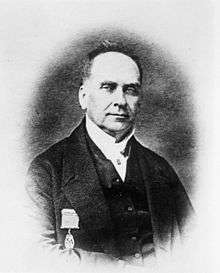Reform movement (pre-Confederation Canada)
 |
| This article is part of a series on the politics and government of Canada |
| Government |
|
|
Related topics |
Reform movement, sometimes erroneously referred to as the Reform Party, began in the 1830s as the movement in the English speaking parts of British North America (Canada). It agitated alternately for republicanism or responsible government.[1]
In Maritime Canada, these movements were also referred to as Liberal, and later became the Liberal parties in those colonies. (See also PEI Liberal Party, New Brunswick Liberal Party, Nova Scotia Liberal Party, Liberal Party of Newfoundland). The most prominent Reformer in the Maritimes was Joseph Howe.
In Upper Canada (Ontario), the Reform movement was formed in opposition to the Family Compact.[2] It was led initially by William Lyon Mackenzie, who became the principal figure in the Upper Canada Rebellion of 1837. Mackenzie went into exile as a result of the failed rebellion. The uprising led to the 1839 Durham Report, which recommended responsible government and the union of Upper and Lower Canada as a means of assimilating Francophones. Only the union of the Canadas was to be immediately implemented.
In 1841, the Act of Union went into effect. Upper Canada became Canada West, forming with Canada East (Quebec) the United Province of Canada. The leaders of the Reform movement in Canada West at this point were Robert Baldwin and Francis Hincks. The Reformers worked with Louis-Hippolyte LaFontaine and the Parti rouge to form government at various points in the 1840s.They eventually succeeded in obtaining a democratically accountable executive and the first administration under the principle of responsible government came to power in 1848.


The Reformers were more a loose movement than a party. Individual members voted independently on various issues. By the 1850s, the Reform movement had dissipated: moderate reformers had joined with Tories in 1854 to form a Liberal-Conservative coalition government under the leadership of John A. Macdonald and George-Étienne Cartier. This was the basis of what was to become the Conservative Party.
Left wing Reformers, along with the Clear Grits, promoted electoral reform, and reciprocity with the United States. In 1857, under the leadership of George Brown, the Clear Grits and left wing Reformers formed the Liberal Party in Canada West and, with the Parti rouge and Maritime Liberal parties, formed the basis for the Liberal Party of Canada.
See also
- The Reform Movement (Upper Canada)
- Province of Canada
- Liberalism
- Contributions to liberal theory
- Liberalism worldwide
- List of liberal parties
- Liberal democracy
- Liberalism in Canada
References
- ↑ Romney, Paul (1999). Getting it Wrong: How Canadians Forgot Their Past and Imperilled Confederation. Toronto: University of Toronto Press. pp. 57–8.
- ↑ The Canadian Encyclopedia : Reform Movement in Upper Canada
